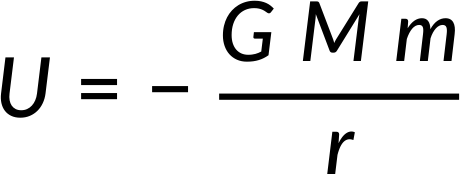Newton's law of gravitation describes the gravitational force between any two point masses. However, for extended spherical objects like the Earth, the Moon, and other planets, the law holds with an assumption that masses of spherical objects are concentrated at their respective centers.
This assumption can be proved easily by showing that the expression for gravitational potential energy between a hollow sphere of mass (M) and a point mass (m) is the same as it would be for a pair of extended spherical solid objects.
Consider a tiny ring of width Rdϕ and mass dM on the surface of a spherical hollow sphere at a distance s from the point mass as shown in Figure 1(a).
The gravitational potential energy between the ring and the point mass (m) is expressed as:

The ratio of the ring's mass to the entire shell's mass is equal to the ratio of the ring's area to the shell's area. Therefore, on simplification, the ring's mass can be expressed as:

Now, the square of distance (s) can be expressed as the sum of squares of the triangle's other two sides, as seen in Figure 1(b).
Simplifying further and taking differentials on either side,

Considering the entire shell, s can vary between r − R and r + R, as seen in Figure 1(c).
Therefore, substituting dM and s in the potential energy equation and integrating within the limits of r − R to r + R, the relation obtained is the potential energy between point masses m and M at a distance r.

Therefore, the assumption is proven.
Since force is a derivative of potential energy, the assumption holds for gravitational forces between two spherically solid objects like the Earth and the Moon. Therefore, Newton's law of gravitation can be used to determine the gravitational force between the Earth and the Moon, and the Earth and the Sun.
Aus Kapitel 14:

Now Playing
14.4 : Gravity between Spherical Bodies
Gravitation
8.1K Ansichten

14.1 : Gravitation
Gravitation
6.0K Ansichten

14.2 : Newtons Gesetz der Gravitation
Gravitation
11.6K Ansichten

14.3 : Gravitation zwischen kugelsymmetrischen Massen
Gravitation
804 Ansichten

14.5 : Reduzierte Massenkoordinaten: Isoliertes Zweikörperproblem
Gravitation
1.2K Ansichten

14.6 : Beschleunigung durch Schwerkraft auf der Erde
Gravitation
10.3K Ansichten

14.7 : Beschleunigung durch Schwerkraft auf anderen Planeten
Gravitation
4.0K Ansichten

14.8 : Das scheinbare Gewicht und die Erdrotation
Gravitation
3.5K Ansichten

14.9 : Variation der Beschleunigung aufgrund der Schwerkraft in der Nähe der Erdoberfläche
Gravitation
2.3K Ansichten

14.10 : Potentielle Energie durch Gravitation
Gravitation
4.8K Ansichten

14.11 : Das Prinzip der Überlagerung und des Gravitationsfeldes
Gravitation
1.2K Ansichten

14.12 : Fluchtgeschwindigkeit
Gravitation
4.9K Ansichten

14.13 : Zirkuläre Umlaufbahnen und kritische Geschwindigkeit für Satelliten
Gravitation
2.8K Ansichten

14.14 : Energie eines Satelliten in einer kreisförmigen Umlaufbahn
Gravitation
2.1K Ansichten

14.15 : Keplers erstes Gesetz der Planetenbewegung
Gravitation
3.8K Ansichten
See More
Copyright © 2025 MyJoVE Corporation. Alle Rechte vorbehalten